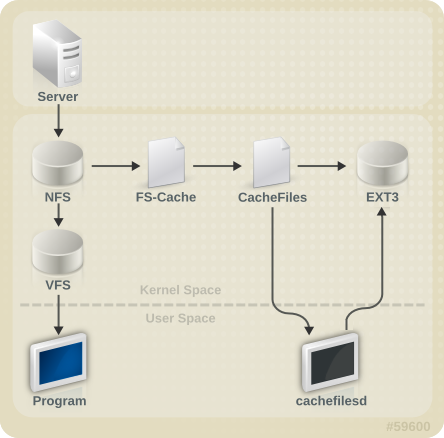Chapter 10. FS-Cache
FS-Cache is a persistent local cache that can be used by file systems to take data retrieved from over the network and cache it on local disk. This helps minimize network traffic for users accessing data from a file system mounted over the network (for example, NFS).
The following diagram is a high-level illustration of how FS-Cache works:
Figure 10.1. FS-Cache Overview
FS-Cache is designed to be as transparent as possible to the users and administrators of a system. Unlike
cachefs on Solaris, FS-Cache allows a file system on a server to interact directly with a client's local cache without creating an overmounted file system. With NFS, a mount option instructs the client to mount the NFS share with FS-cache enabled.
FS-Cache does not alter the basic operation of a file system that works over the network - it merely provides that file system with a persistent place in which it can cache data. For instance, a client can still mount an NFS share whether or not FS-Cache is enabled. In addition, cached NFS can handle files that won't fit into the cache (whether individually or collectively) as files can be partially cached and do not have to be read completely up front. FS-Cache also hides all I/O errors that occur in the cache from the client file system driver.
To provide caching services, FS-Cache needs a cache back-end. A cache back-end is a storage driver configured to provide caching services (i.e.
cachefiles). In this case, FS-Cache requires a mounted block-based file system that supports bmap and extended attributes (e.g. ext3) as its cache back-end.
FS-Cache cannot arbitrarily cache any file system, whether through the network or otherwise: the shared file system's driver must be altered to allow interaction with FS-Cache, data storage/retrieval, and metadata set up and validation. FS-Cache needs indexing keys and coherency data from the cached file system to support persistence: indexing keys to match file system objects to cache objects, and coherency data to determine whether the cache objects are still valid.
Note
Starting with Red Hat Enterprise Linux 6.2,
cachefilesd is not installed by default and needs to be installed manually.
10.1. Performance Guarantee
Copy linkLink copied to clipboard!
FS-Cache does not guarantee increased performance, however it ensures consistent performance by avoiding network congestion. Using a cache back-end incurs a performance penalty: for example, cached NFS shares add disk accesses to cross-network lookups. While FS-Cache tries to be as asynchronous as possible, there are synchronous paths (e.g. reads) where this isn't possible.
For example, using FS-Cache to cache an NFS share between two computers over an otherwise unladen GigE network will not demonstrate any performance improvements on file access. Rather, NFS requests would be satisfied faster from server memory rather than from local disk.
The use of FS-Cache, therefore, is a compromise between various factors. If FS-Cache is being used to cache NFS traffic, for instance, it may slow the client down a little, but massively reduce the network and server loading by satisfying read requests locally without consuming network bandwidth.
